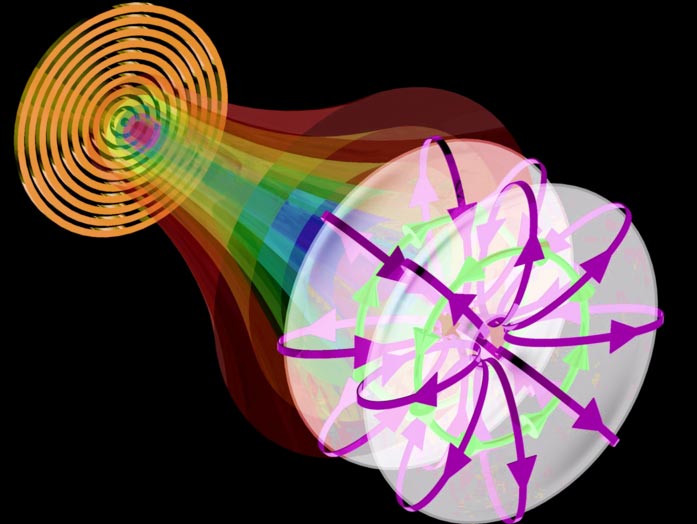A review of “classical entanglement” blurring quantum-classical divide

Credit by Yijie Shen
Entanglement or non-separability constitutes a cornerstone of quantum mechanics from which many of its unique characteristics arise. For example, non-separability in entangled particle pairs leads to apparent instantaneous transfer of information and counterintuitive states of matter. Such phenomena find applications in diverse areas, such as quantum computing or quantum cryptography. Nevertheless, non-separability is also ubiquitous in the classical domain. Indeed, even prism dispersion of light as observed by Newton over three centuries ago can be considered as an example of non-separable light. However, non-separability in classical systems, or “classical entanglement” is little explored and in a fragmented fashion, while its potential is certainly not fully exploited.
Over the last few years, there has been a surge of interest in non-separable optical systems, typically involving free-space propagating beams and pulses. To this end, the on-demand design and generation of non-separable classical states of light using its various degrees of freedom, such as space, polarization, frequency, and propagation path amongst others has become crucial. The concept of non-separability in optics is now being extended to space-time non-separable pulses and ray-wave coupled geometric light. Recently, a review published in Laser & Photonics Reviews (https://doi.org/10.1002/lpor.202100533) propose a comprehensive review of non-separability in classical light providing a perspective on the opportunities for both fundamental science and applications. This review provides a bird’s eye view on the rapidly growing, but incoherent, body of work on non-separable classical states involving different degrees of freedom of light and will introduce a unified framework for their classification, which is extremely timely and of much needed perspective on the field and its applications.
The outline of the review:
1. Introduction: This chapter introduces the concept of non-separability and how it applies to classical states of light and typically employed Degrees of Freedom (DoFs) of light, provides an overview of approaches for the construction of non-separable light states, and illustrates the similarities and differences between classical and quantum light states by tutorial examples including coherent states and cat states.
2. Analogies between Quantum and Classical: This chapter provides the mathematical description of classical light states borrowing tools from quantum mechanics, showing formal analogies between quantum states and classical eigenmodes. More precisely, it shows that non-separable states of classical light can be derived from a Schrödinger-like equation. This in turn allows to describe many properties of classical light with methods typically employed in quantum mechanics, thus providing a theoretical framework to construct classical non-separable states.
3. Two-DoF nonseparable states of light: Classical non-separable states with two DoFs can be described analogously to bipartite entangled quantum states (e.g. Bell state). Here discuss classical analogs of two-dimensional Bell states, such as space-polarization non-separable states (e.g. vector vortex beams) and space-time non-separable states as higher-dimensional Bell states (e.g. focused pancake pulses); Examples of other bipartite states with it classical analog structured light are also discussed.
4. Multi-DoF nonseparable states of light: This chapter discusses non-separable states with multiple DoFs, e.g. the quantum Greenberger–Horne–Zeilinger state. Such exotic states of structured light include the ray-wave-polarization non-separable beam and space-time-polarization non-separable pulse.
5. Applications of nonseparable states of light: This chapter puts forward a roadmap for the development of classical non-separable states and give perspective on challenges as well as potential applications in optical metrology, sensing, optical communication, cryptography, computation.
6. Conclusions and Perspectives: This chapter provides a perspective on new opportunities of diversified non-separable states of light for both fundamental science and applications in the near future.
Journal: Laser & Photonics Review
DOI: 10.1002/lpor.202100533
Media Contact
All latest news from the category: Physics and Astronomy
This area deals with the fundamental laws and building blocks of nature and how they interact, the properties and the behavior of matter, and research into space and time and their structures.
innovations-report provides in-depth reports and articles on subjects such as astrophysics, laser technologies, nuclear, quantum, particle and solid-state physics, nanotechnologies, planetary research and findings (Mars, Venus) and developments related to the Hubble Telescope.
Newest articles

Innovative 3D printed scaffolds offer new hope for bone healing
Researchers at the Institute for Bioengineering of Catalonia have developed novel 3D printed PLA-CaP scaffolds that promote blood vessel formation, ensuring better healing and regeneration of bone tissue. Bone is…

The surprising role of gut infection in Alzheimer’s disease
ASU- and Banner Alzheimer’s Institute-led study implicates link between a common virus and the disease, which travels from the gut to the brain and may be a target for antiviral…

Molecular gardening: New enzymes discovered for protein modification pruning
How deubiquitinases USP53 and USP54 cleave long polyubiquitin chains and how the former is linked to liver disease in children. Deubiquitinases (DUBs) are enzymes used by cells to trim protein…


